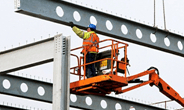Analysis

December 7, 2021
AGC: Construction Industry Adds More Jobs in November
Written by David Schollaert
The U.S. construction sector saw 31,000 new employees added to payrolls in November. Even though nonresidential construction firms added workers for a third straight month, the sector’s unemployment rate rose 0.7 percentage points to 4.7% during the same period, reports the Associated General Contractors of America (AGC) in its latest analysis of government data.
The industry would likely have added even more jobs in November as contractors cope with record numbers of job openings, but firms continue to struggle to find qualified workers, said AGC.
“It is heartening to see steady job growth across all construction segments following a long period during which only residential contractors were adding employees,” said Ken Simonson, AGC’s chief economist. “But record job openings show the industry needs still more workers as more types of nonresidential projects get started.”
Construction employment in November totaled 7,533,000, an increase of 31,000 since October and the highest seasonally adjusted figure since March 2020. However, industry employment still trails the pre-pandemic peak, set in February 2020, by 115,000 positions.
Nonresidential construction firms added 20,800 employees in November, following a pickup of 34,600 in October. The category comprises nonresidential building contractors, which added 5,900 employees; specialty trade contractors, with a gain of 6,800 workers; and heavy and civil engineering construction firms, with 8,100 more workers than in October.
Nonresidential employment, however, remains 209,000 below the February 2020 level, as the sector has recovered only 67% of the jobs lost in the first two months of the pandemic.
Residential construction added 10,300 employees in November. Residential building contractors such as homebuilders and general contractors that concentrate on multifamily construction, added 4,100 workers during the month. Residential specialty trade contractors added 6,200 employees, and residential employment in November exceeded the February 2020 mark by 95,000 positions.
Simonson noted that the number of job openings in the industry reached 333,000 in September, the latest month available. That amount is an all-time high for the month, he added.
Workforce shortages are likely to become more severe, said the AGC, citing the significant increase in federal infrastructure investments that will follow the enacted Bipartisan Infrastructure Bill. They urged federal officials to boost investments in career and technical education programs that are needed to make more new workers aware of construction career opportunities.
“These new federal investments will create many new career opportunities in construction, now we need to make sure potential workers are aware of those opportunities and prepared to take advantage of them,” said Stephen Sandherr, AGC’s CEO.







